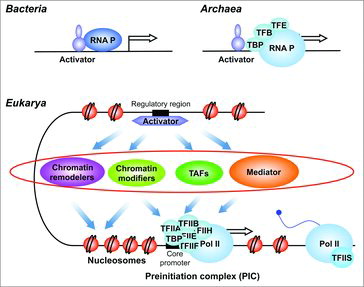Figures & data
Table 1. Mediator subunits in yeast S. cerevisiae and human.Footnote*
Figure 1. Regulation of Pol II transcription initiation. A simplified view of eukaryotic Pol II transcription regulation at the step of preinitiation complex (PIC) formation is shown. Unlike bacteria which have direct links between activators and RNA polymerase or Archaea that have an RNA polymerase closely related to the eukaryotic enzyme and three general transcription factors, eukaryotes have multisubunit coregulators. These complexes constitute an additional regulatory layer (indicated by a red mark), that emerged in the eukaryotic kingdom, operating between activators and basal Pol II transcription machinery in chromatin context. These multisubunit complexes include chromatin remodelers and chromatin modifiers that act on the promoter chromatin structure or TAFs-containing TFIID and Mediator that stimulate PIC assembly. Some complexes could have both activities.

Figure 2. Mediator interactions within the nucleus. Mediator functions are closely related to its physical and functional interactions with nuclear proteins. Some of these contacts discussed in the review are summarized on the figure focusing on Pol II transcription (TF interactions, PIC assembly, promoter proximal pausing), but also extending to chromatin architecture, mRNA export or DNA repair. The cartoon represents a combined view from different studies in yeasts and metazoans. Identified interactions between Mediator and nuclear proteins and ncRNAs are shown. Mediator contacts with SECs, cohesin and ncRNAs were reported in metazoans. Mediator modules are shown in different colors with Med14 linking the three main modules (head, middle and tail).

